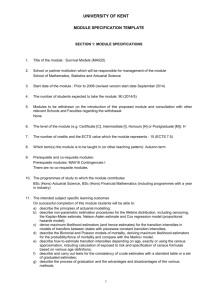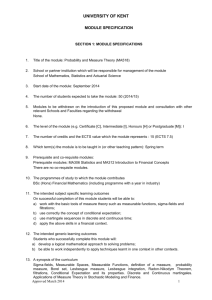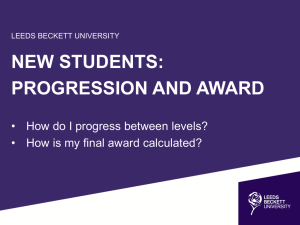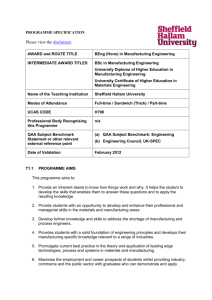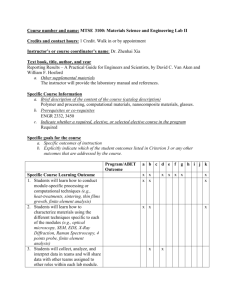Programme (Scheme of Study) Specification
advertisement
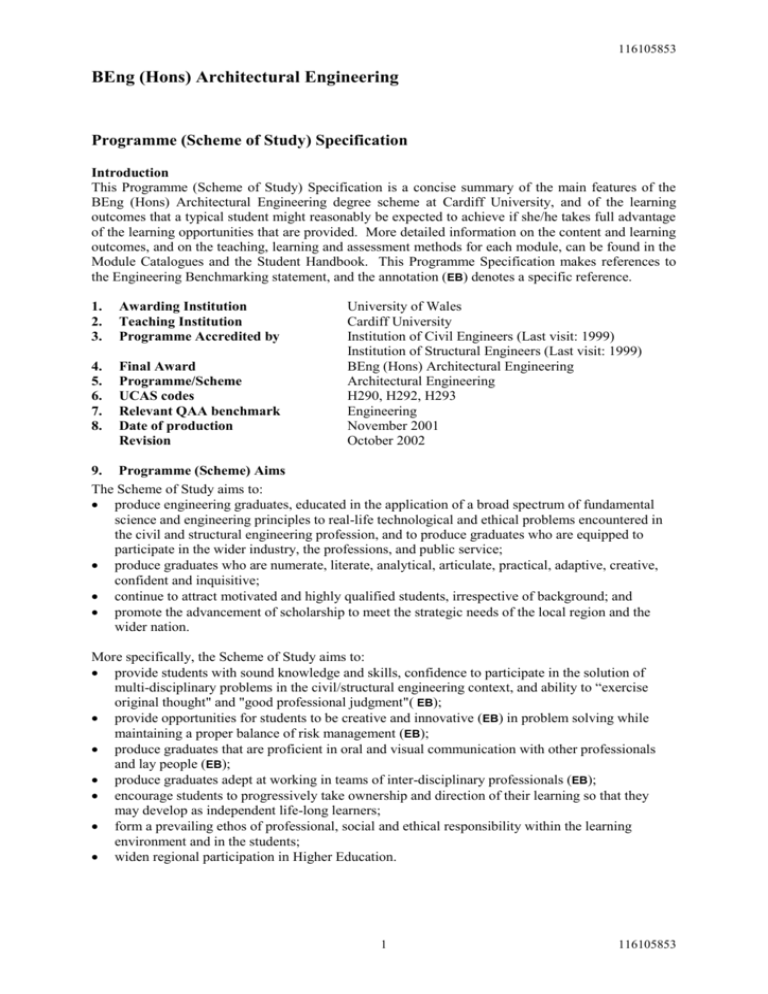
116105853 BEng (Hons) Architectural Engineering Programme (Scheme of Study) Specification Introduction This Programme (Scheme of Study) Specification is a concise summary of the main features of the BEng (Hons) Architectural Engineering degree scheme at Cardiff University, and of the learning outcomes that a typical student might reasonably be expected to achieve if she/he takes full advantage of the learning opportunities that are provided. More detailed information on the content and learning outcomes, and on the teaching, learning and assessment methods for each module, can be found in the Module Catalogues and the Student Handbook. This Programme Specification makes references to the Engineering Benchmarking statement, and the annotation (EB) denotes a specific reference. 1. 2. 3. Awarding Institution Teaching Institution Programme Accredited by 4. 5. 6. 7. 8. Final Award Programme/Scheme UCAS codes Relevant QAA benchmark Date of production Revision University of Wales Cardiff University Institution of Civil Engineers (Last visit: 1999) Institution of Structural Engineers (Last visit: 1999) BEng (Hons) Architectural Engineering Architectural Engineering H290, H292, H293 Engineering November 2001 October 2002 9. Programme (Scheme) Aims The Scheme of Study aims to: produce engineering graduates, educated in the application of a broad spectrum of fundamental science and engineering principles to real-life technological and ethical problems encountered in the civil and structural engineering profession, and to produce graduates who are equipped to participate in the wider industry, the professions, and public service; produce graduates who are numerate, literate, analytical, articulate, practical, adaptive, creative, confident and inquisitive; continue to attract motivated and highly qualified students, irrespective of background; and promote the advancement of scholarship to meet the strategic needs of the local region and the wider nation. More specifically, the Scheme of Study aims to: provide students with sound knowledge and skills, confidence to participate in the solution of multi-disciplinary problems in the civil/structural engineering context, and ability to “exercise original thought" and "good professional judgment"( EB); provide opportunities for students to be creative and innovative (EB) in problem solving while maintaining a proper balance of risk management (EB); produce graduates that are proficient in oral and visual communication with other professionals and lay people (EB); produce graduates adept at working in teams of inter-disciplinary professionals (EB); encourage students to progressively take ownership and direction of their learning so that they may develop as independent life-long learners; form a prevailing ethos of professional, social and ethical responsibility within the learning environment and in the students; widen regional participation in Higher Education. 1 116105853 116105853 10. Programme (Scheme) Outcomes The Programme (Scheme) Outcomes have been informed by the Engineering Benchmark Statement and also by the requirements of the Institution of Civil Engineers and the Institution of Structural Engineers, through the Joint Board of Moderators (SARTOR3). Students who gain the award will have demonstrated achievement of the following Intended Learning Outcomes, as set out under Sections A, B, C, and D in the table below. Intended Outcomes Upon completion of the scheme a typical student will have: 10A knowledge and understanding of Teaching/learning strategies and methods 1 basic mathematics and science relevant to Items 1 & 2 are achieved through a combination of Engineering (EB), lectures, tutorials, example classes, laboratory 2 fundamental “concepts, principles and theories” sessions, online exercises and coursework (e.g. relevant to Civil and Structural Engineering (EB), design) in Years 1 and 2. 3 business and management techniques in an Item 3 is achieved through a combination of lectures engineering context (EB), and tutorials in Year 1 (e.g.EN1014) and Year 3 4 basic construction and building technology (EB), (e.g. EN3001, EN3337). 5 the responsible role played the engineer in Item 4 is achieved through a combination of lectures society, exercising “professional and ethical” and tutorials, and external site visits, in Years 1 judgement (EB); (e.g. EN1044) and 3 (e.g. EN3201, EN3336). Item 5 is achieved through a combination of lectures and seminars, principally in Year 3 (e.g. EN3002). Students are expected to undertake independent guided study, and progressively gain confidence in independent learning. 10B intellectual skills to 1 correctly identify and evaluate a problem and apply appropriate tools from the curriculum and experience for solution, 2 formulate and test hypotheses (EB), 3 be creative and innovative in solving problems and in the design of structures and their components (EB), 4 evaluate designs/assess integrity and make improvements (EB), 5 plan, conduct and report on an original investigative programme (EB), 6 “assess risks and take appropriate steps to manage those risks”( EB); 2 Assessment Knowledge and understanding is assessed summatively through unseen written examinations, coursework, project reports, audio-visual presentations, technical reports, and viva voce. Formative feedback is provided through in-course tests, tutorials, laboratory sessions, laboratory reports, coursework (e.g. design reports), and presentations. Teaching/learning strategies and methods Intellectual skills are developed as part of the teaching and learning strategies outlined in Section 10A. In particular problem solving skills are tested and honed in design exercises encountered throughout all four years of study. The design problems in Year 3 involve team work and are more open-ended. Experimental, research and design skills are principally developed through coursework and laboratory sessions. Skill 3 is primarily achieved in the Design Studio (EN3208). Skills 2 and 4 are primarily achieved through laboratory sessions and the double module Final Year Project (EN3207). Skills 1 and 5 form part of the fundamental aims of the Final Year Project. Skill 7 is achieved principally through the study of fundamental concepts and case studies, in modules such as EN3002, EN4317 and EN4318. 116105853 116105853 10C discipline specific (including practical) skills to 1 plan and conduct safely an experimental or computational investigation, 2 evaluate and present investigative results, and determine their significance, validity and limitation, 3 use a range of equipment for laboratory testing commonly encountered in Civil/Structural Engineering (EB), 4 assess risks involved in experimental work, and working in a laboratory environment (EB), 5 use a range of analytical, graphical and presentational software packages commonly encountered in the Civil/Structural Engineering profession (EB), 6 prepare and understand technical reports and drawings, 7 use a range of land surveying equipment for setting out engineering works and for collecting site data for the production of engineering plans, 8 take effective notes and distil key elements from a large corpus of information (e.g. a literature search); 10D transferable skills to 1 communicate effectively, both in writing and orally (EB), 2 use IT effectively (EB), 3 manage resources and time (EB), 4 undertake lifelong learning, particularly for continuing professional development (EB), 5 transfer methodologies and solution techniques native to one field to a foreign field. Assessment Intellectual skills are assessed summatively through unseen written examinations, coursework, project and technical reports. Formative feedback is provided most significantly through design classes, tutorials, laboratory sessions, laboratory reports, project tutorials, and coursework (e.g. design reports). Teaching/learning strategies and methods Practical skills are principally developed via coursework, laboratory sessions, design assignments and projects, guided study, but also through lectures. Skills 1-4 and 6 are achieved via laboratory modules and in the Final Year project. Skill 5 is achieved in IT based modules (e.g. EN1028, EN2007) and is further developed in design modules and the Final Year Project. Skill 7 is achieved in EN1044, and consolidated through a residential field course. Skill 8 is achieved in almost all modules, and particularly exercised in the Final Year Project. Assessment Practical skills are assessed through laboratory reports, design reports, and project reports. Teaching/learning strategies and methods Transferable skills are principally developed as part of the learning activities already listed above. Skill 1 is principally achieved in laboratory modules and in the Final Year Project. Skill 2 is principally achieved in the IT modules (EN1028, EN2007) but also further developed in the laboratory modules and Final year Project. Skill 3 is acquired throughout the Scheme, but is more acutely exercised in the laboratory modules, design modules, and in the Final Year Project. Skill 4 is initiated in Year 1 through the issue of a Professional Record Folder to each student as part of professional studies (e.g. in EN1014) and then subsequently monitored through the Personal Tutorial system in higher years. Skill 5 is principally acquired in the Final Year Project. Assessment Transferable skills are typically assessed through the successful completion of coursework, on time and without detriment to other activities. Skill 1 is assessed as part of coursework submission in Year 1 Professional Studies, in management modules in Year 3, in the Final Year Project 3 116105853 116105853 (presentation and viva voce) and also in other modules (e.g. EN3208). 11. Programme (Scheme) structure and requirements, courses and awards Details of the Scheme structures and requirements, courses and awards are available in the Student Handbook. A module represents 80 hours of programmed study, and typically involves 36 hours of contact time with teaching staff. In summary, the BEng Scheme is offered in full-time (3 year, H292) mode, with sandwich industrial training (4 year, H293) and year in Europe (in France, Spain or Germany, 4 year, H290) extensions. These four-year alternatives involve a one year placement away from Cardiff between the second and third years of academic study at Cardiff. In each year of the scheme students take modules up to the value of 120 credits (130 credits for Year in Europe). A choice of modules is available during each year of study; most choices are found in Year 3. The award of a BEng (Hons) degree is conditional on successful progression in all years. A current “Threads Diagram” is provided above to give an overall view of the Scheme Structure. 12. Other Features The distinctive features of the Scheme include: the opportunity for students to learn in a research-led teaching institution serviced by staff rated in the highest possible category by independent Government assessment (Cardiff Civil Engineering was rated 5*A in the 2001 RAE, and all staff are involved in teaching); the opportunity to work in facilities commensurate with a 5*A research unit; academic staff who are Chartered Engineers; a variety of advanced level modules on offer; the opportunity to study a language, and to study abroad; the opportunity to follow a sandwich year in industry and through this gain a City and Guilds Licenciateship; emphasis on progression towards independent learning in preparation for life-long learning; 4 116105853 116105853 full accreditation, subject to completion of appropriate Matching Sections, for Membership of the Institution of Civil Engineers and the Institution of Structural Engineers, and registration as a Chartered Engineer. Additional Information Criteria for admission to the Programme (Scheme) are reviewed at least annually and are made available on the web: http://engin.cf.ac.uk/teaching/undergrd/architec/index.html file://nprdcf3s/engin00/shared/adminwww/regs/appenda.doc Information about assessment regulations: see Scheme Regulations, http://engin.cf.ac.uk/teaching/undergrd/architec/index.html file://nprdcf3s/engin00/shared/adminwww/regs/bengfsy.doc Methods for evaluating and improving the quality and standards of learning include: Annual Review of Scheme (report made public in the School); Periodic Review; Academic Validation of Schemes of Study; External Examiners Reports (made annually); Accreditation Reports; Student Module Evaluations (each student makes an anonymous evaluation on each of his/her modules, and results are made public in the School); Student/Staff Sub-groups (with minutes made public in the School); Student Representatives on Sub-Board of Studies; Staff Appraisal; Staff Peer Review of Teaching. 5 116105853
